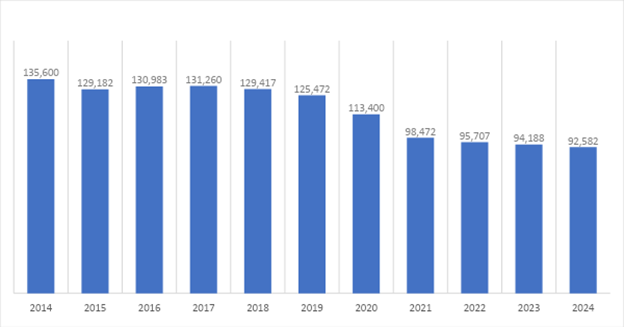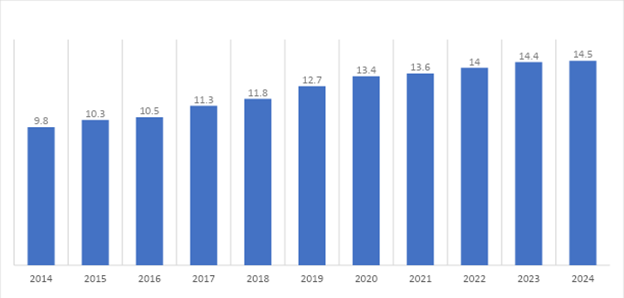In 2014, Californians voted overwhelmingly to pass Proposition 47, known by its supporters title the “Safe Neighborhoods and Schools Act.” Prop 47’s advocates made a strong case, promising that both crime and incarceration rates would decline. At the same time, supporters argued that “massive” savings from ending the practice of incarcerating non-violent offenders and no longer prosecuting minor property crimes and drug possession as felonies would be a windfall for our schools. Los Angeles County District Attorney George Gascón, Retired San Diego Chief of Police William Landsdowne, and Victim Advocate Dionne Wilson wrote in the 2014 ballot argument that, “Proposition 47 invests in solutions supported by the best criminal justice science, which will increase safety and make better use of taxpayer dollars.”
A decade later, the question is where are those dollars and how have they been spent? Prop 47 requires that alleged budget savings be spent on mental health and drug treatment programming. That programming is facilitated by the California Board of State and Community Corrections (BSCC) who, in February, released its Proposition 47 Cohort II Statewide Evaluation report. Cohort II is the second of four Prop 47 grant cycles and shows that for the one-year grant period from 2022-2023, the BSCC awarded $92.7 million in grants that were dispersed to 21 jurisdictions including probation departments, health services agencies, school districts and cities. Together, these dollars served 21,706 Prop 47 participants.
Additionally, Cohort I grantees received $103.6 million and served 32,007 Prop 47 offenders, Cohort III grantees received $111.5 million and the distribution is in progress, while Cohort IV awards are in process and $152 million has been budgeted for them.
This brings total BSCC grant spending on Prop 47 services to $459.8 million.
Spending half a billion dollars over a decade works out to, in the words of a friend, “budget dust” given that California law enforcement arrested 780,888 individuals in 2022 – a 31% increase over 2019 levels.
BSCC is claiming significant success in programs that are not independently audited and, in fact, are managed in some cases by veterans of the very agencies they fund. Probation departments and their contract non-profits are under no obligation to accurately record program failures, and define their own criteria for success. Consequently, recidivism statistics that show an improvement over non-Prop 47 recipients are unreliable.
While prison populations have declined since Prop 47’s passage, much of that reduction was due to the passage of AB 109 in 2011, also known as realignment. AB109 transferred the so-called “triple nons” (non-violent, non-serious, and non-sexual offenders) to county jails, thus allowing the State to offload its corrections burden onto counties.

Yet, advocates of Prop 47 insist that this reduction in the state prison population should be credited to Prop 47. Certainly, some inmates benefited from Prop 47’s retroactivity but the real benefit to the CDCR population statistics is realignment.
Prop 47 offenders also benefit from the fact that county jails have become local state prisons that house felons and release misdemeanants due to operational constraints.
But the question remains – where are the “massive savings” promised by Gascón, Landsdowne, and Wilson?
The CDCR budget has grown even while its population has declined. The above chart shows the inmate population declined 31.7% from 2014 to 2024 (to date), while at the same time the below chart shows the CDCR budget has increased a whopping 47.9%. Labor and medical care costs are rising faster than the State can reduce the population. Given the current rates of declining population and increasing budgets by 2034 it will cost $21.4 billion to house 73,139 inmates. California currently ranks 33rd amongst all states in rates of incarceration. Mississippi is first and Maine is last.

On July 23, the New York Times reported that “Frustrated Californians May Be Ready for a Tougher Approach to Crime,” noting that Los Angeles experienced an 81% increase in shoplifting in 2023. A San Francisco Chronicle/Stanford University survey found that 75% of San Franciscans had experienced a loss due to theft. That’s 600,000 people in one city alone. This is despite “official statistics” that reported a total of roughly 800,000 property crimes statewide. The math just doesn’t add up.
As for education spending, Ed Source reports that California’s per pupil spending is $2,000 below average US per pupil spending and ranks California’s students amongst the lowest performing in America. Not that spending alone will improve what PRI’s Lance Izumi identifies as systemic public school failures in his recent book, The Great Classroom Collapse. Additionally, like faulty crime rates, GPA inflation and other bogus measures of student performance have been debunked as even students with “high” GPA’s are scoring lower and lower on standardized examinations.
A society cannot decriminalize its way to lower crime rates any more than politicians can promise schools are improving by inflating grades and declaring that student performance is up.
It appears the jig is up.
Steve Smith is a senior fellow in urban studies at the Pacific Research Institute, focusing on California’s growing crime problem.


